|
Space Craft |
Info |
CPU |
Pioneer 10 & 11
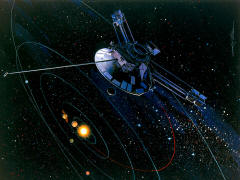 |
1972 |
Custom CPU in TTL
A popular
myth has it that Pioneer 10 used an Intel 4004. |
|
Pioneer 10was the
first spacecraft to travel through the asteroid belt. It is
surely the first human-built object to have been set upon a
trajectory leading out of the solar system. The last signal from
Pioneer 10 was received on January 23, 2003, when it was 7.5
billion miles from Earth. |
Skylab
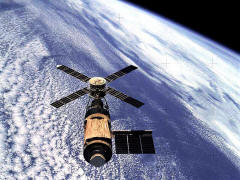 |
1973 |
TC-1
a space qualified IBM 360 system,
16 bit technology. The software of
the CPU was compatible
to the AP 101 |
|
Skylab was the
United States' first space station, and the second space station
visited by a human crew. It was also the only space station NASA
launched alone. The 100-ton space station was in Earth's orbit
from 1973 to 1979. |
Viking
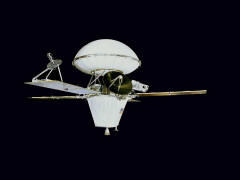 |
1976 |
RCA 1802
Viking was controlled by a RCA 1802
microprocessor CPU,
and fabricated on sapphire (Silicon on Sapphire) which is a radiation-and
static-hardened material ideal for spacecraft operation. |
|
NASA's Viking
program consisted of a pair of space probes sent to Mars. It was
the most expensive and ambitious mission ever sent to Mars. It
was highly successful and formed most of the database of
information about Mars until the late 1990s. After separation
and landing, the lander had a mass of about 600 kg and the
orbiter 900 kg.
Picture of Lander |
Voyager 1 & 2
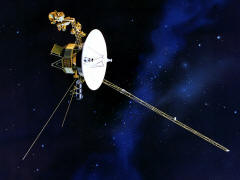 |
1977 |
RCA 1802
Voyager have three RCA 1802 CPUs running at
6.4 MHz. These CPUs sent to space were operating at full
military specification temperatures
(-55 to +125 °C). |
|
Voyager 1 is
currently the farthest human-made object from Earth, traveling
away from both the Earth and the Sun at a speed that corresponds
to a greater specific energy than any other probe. In 1990,
Voyager 1 took the first ever "family portrait" of our solar
system as seen from outside! It is estimated that both Voyager
crafts have sufficient electrical power to operate their radio
transmitters until at least after 2025. |
Space Shuttle
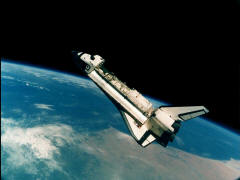 |
1981 |
Intel 8086 and RCA 1802 (display controller) - Later Intel 80386
The Space shuttle uses the APA-101S computer
(5 of them for redundancy). It use a couple megs of ferrite core
memory (which is impervious to radiation). The entire control
software for the shuttle is less then one meg. The new glass
cockpit in the shuttle runs on Intel 80386s |
|
The Shuttle is the
first orbital spacecraft designed for partial reusability. It
carries payloads to low Earth orbit and performs servicing
missions. The orbiter can also recover satellites and other
payloads from orbit and return them to Earth. |
Galileo
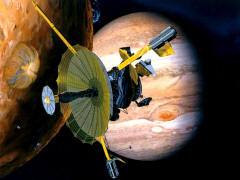 |
1989 |
RCA 1802
AMD 2901
The spacecraft was controlled by a RCA 1802
Cosmac microprocessor CPU, at about 1.6 MHz.
The Attitude and Articulation Control Subsystem was controlled
by 2x4 pieces
2901 bitslice processors. 4 chips
make a full CPU.
|
|
Galileo was an
unmanned spacecraft sent by NASA to study the planet Jupiter and
its moons. It arrived at Jupiter in 1995. At launch, the orbiter
and probe together had a mass of 2,564 kilograms and was seven
meters tall. 2003 Galileo's mission was terminated by sending
the orbiter into Jupiter's atmosphere at a speed of nearly 50
kilometers per second. |
Hubble Space
Telescope
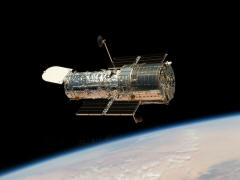 |
1990 |
80486
Originally a DF-224 (8-bit).
On the first service mission
added a 386 coprocessor.
The Hubble now runs on a 80486 |
The Hubble Space
Telescope is a space telescope that was carried into orbit by
the space shuttle in April 1990. It has a mass of 11100 kg.
Diameter: 2,4m ; Collecting
era: 4,5 m˛; Focal length: 57,4 m; Orbit
high: 559 km; Orbit velocity: 7500 m/s |
Sojourner (on Mars)
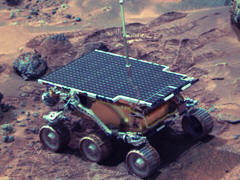 |
1996 |
Intel 80C85
The embedded computer on board the Sojourner
rover was based around
the 100 KHz Intel 80C85 CPU with
512 KB of RAM and 176 KB of flash memory solid-state storage. |
The probe consisted
of a lander and a lightweight (10.6 kilograms/23 pounds) wheeled
robot (Rover) called Sojourner.
The robot was remotely controlled, but had a basic
camera-assisted autonomous control system allowing it to
navigate and negotiate minor obstacles without operator
intervention. |
International
Space Station
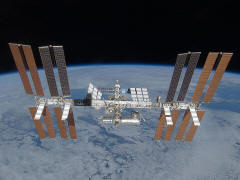 |
1998 |
Intel 80386SX-20 & 80387
There are several computers on the ISS. The
most important are the command computers which use the i386. |
|
The ISS is a
research facility currently being assembled in Low Earth Orbit.
On-orbit construction of the station began in 1998, and is
scheduled to be complete by 2011, with operations continuing
until around 2015. As of 2009 the ISS is the largest artificial
satellite in Earth orbit, larger than any previous space
station. |
Spirit & Opportunity
Rovers
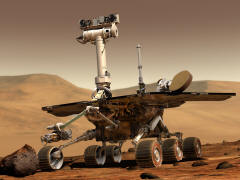 |
2004 |
BAE RAD6000 (25MHz Max)
The RAD6000 radiation-hardened single board
computer, based on the IBM RISC Single Chip CPU, was
manufactured by IBM. |
|
Primary among the
mission's scientific objectives is to search for and
characterize a wide range of rocks and soils that hold clues to
past water activity on Mars. The rovers are six-wheeled,
solar-powered robots which stand 1.5 m high, 2.3 m wide and 1.6
m long. They weigh 180 kg, 35 kg of which is the wheel and
suspension system. |
USS Enterprise
NCC-1701
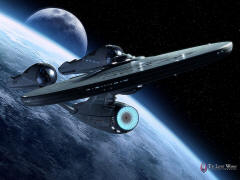 |
2286 |
IBMTEL MOCM
(Multi Organic Core Module)
neural
system included
awareness. |
The USS Enterprise
is providing
a antimatter engine and a material transporter. This transporter
allows also
to beam humans on the surface of a planet. The maximum velocity
is warp 10. |












